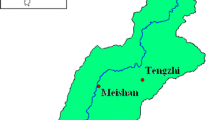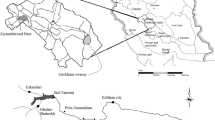Abstract
A hybrid genetic and neurofuzzy computing algorithm was developed to enhance efficiency of water management for a multipurpose reservoir system. The genetic algorithm was applied to search for the optimal input combination of a neurofuzzy system. The optimal model structure is modified using the selection index (SI) criterion expressed as the weighted combination of normalized values of root mean square error (RMSE) and maximum absolute percentage of error (MAPE). The hybrid learning algorithm combines the gradient descent and the least-square methods to train the genetic-based neurofuzzy network by adjusting the parameters of the neurofuzzy system. The applicability of this modeling approach is demonstrated through an operational study of the Pasak Jolasid Reservoir in Pasak River Basin, Thailand. The optimal reservoir releases are determined based on the reservoir inflow, storage stage, sideflow, diversion flow from the adjoining basin, and the water demand. Reliability, vulnerability and resiliency are used as indicators to evaluate the model performance in meeting objectives of satisfying water demand and maximizing flood prevention. Results of the performance evaluation indicate that the releases predicted by the genetic-based neurofuzzy model gave higher reliability for water supply and flood protection compared to the actual operation, the releases based on simulation following the current rule curve, and the predicted releases based on other approaches such as the fuzzy rule-based model and the neurofuzzy model. Also the predicted releases based on the newly developed approach result in the lowest amount of deficit and spill indicating that the developed modeling approach would assist in improved operation of Pasak Jolasid Reservoir.
Similar content being viewed by others
References
Celeste AB, Suzuki K, Kadota A (2004) Genetic algorithms for real-time operation of multipurpose water resource systems. J Hydroinform 6:19–38
Chandramouli V, Deka P (2005) Neural network based decision support model for optimal reservoir operation. Water Resour Manag 19(4):447–464
Chang JX, Huang O, Wang YM (2005) Genetic algorithms for optimal reservoir dispatching. Water Resour Manag 19(4):321–331
Cheng C, Chau KU (2001) Fuzzy iteration methodology for reservoir flood control operation. J Am Water Resour Assoc 37(5):1381–1388
Dubrovin T, Jolma A, Turunen E (2002) Fuzzy model for real-time reservoir operation. J Water Resour Plan Manage 128(1):66–73
Fontane DG, Gates TK, Moncada E (1997) Planning reservoir operations with imprecise objectives. J Water Resour Plan Manage 123(3):154–162
Gautam DK, Holz KP (2001) Rainfall-runoff modelling using adaptive neuro-fuzzy systems. J Hydroinform 3:3–10
Hasebe M, Nagayama Y (2002) Reservoir operation using the neural network and fuzzy systems for dam control and operation support. Adv Eng Softw 33(5):245–260
Holland JH (1975) Adaptation in natural and artificial systems. The University of Michigan Press, Ann Arbor
Jain SK, Das A, Srivastava DK (1999) Application of ANN for reservoir inflow prediction and operation. J Water Resour Plan Manage 125(5):263–271
Jang JSR (1993) ANFIS: adaptive-network-based fuzzy inference systems. IEEE Trans Syst Man Cybern 23(3):665–685
Katayama R, Kajitani Y, Kuwata K, Nishida Y (1993) Self generating radial basis function as neuro-fuzzy model and its application to nonlinear prediction of chaotic time series. Paper presented at the 2nd international conference on fuzzy systems (Fuzzy-IEEE’93), San Francisco, California, 1993:407–414
Kuo JT, Cheng WC, Chen L (2003) Multiobjective water resources systems analysis using genetic algorithms-application to Chou-Shui River Basin, Taiwan. Water Sci Technol 48(10):71–77
Labadie JW (2004) Optimal operation of multireservoir systems: state-of-the-art review. J Water Resour Plan Manage 130(2):93–111
Mamdani EH, Assilian S (1975) An experiment in linguistic synthesis with a fuzzy logic controller. Int J Man-Mach Stud 7(1):1–13
Oliveira R, Loucks DP (1997) Operating rules for multireservoir systems. Water Resour Res 33(4):839–852
Owen WJ, Gated TK, Flug M (1997) Variability in perceived satisfaction of reservoir management objectives. J Water Resour Plan Manage 123(3):147–153
Pinthong P, Das Gupta A, Babel MS, Weesakul S (2006) Daily streamflow forecasting using genetic algorithm based neurofuzzy approach. Paper presented at the 7th international conference on hydroinformatics (HIC2006): Innovate and Share. Acropolos, Nice
Raman H, Chandramouli V (1996) Deriving a general operating policy for reservoirs using neural network. J Water Resour Plan Manage 122(1):342–347
Russell SO, Campbell PE (1996) Reservoir operating rule with fuzzy programming. J Water Resour Plan Manage 122(3):165–170
Sharif M, Wardlaw R (2000) Multireservoir systems optimization using genetic algorithms: case study. J Comp Civ Eng 14(4):255–263
Shrestha BP, Duckstein L, Stakhiv EZ (1996) Fuzzy rule-based modeling of reservoir operation. J Water Resour Plan Manage 122(4):262–269
Simonovic SP (1992) Reservoir systems analysis: closing gap between theory and practice. J Water Resour Plan Manage 118(3):262–280
Takagi T, Sugeno M (1985) Fuzzy identification of systems and its applications to modeling and control. IEEE Trans Syst Man Cybern 15:116–132
Vernieuwe H, Georgieva O, Bernard DB, Valentijn RNP, Niko ECV, Francois PDT (2005) Comparison of data-driven Takagi-Sugeno models of rainfall-discharge dynamics. J Hydrol 302(1–4):173–186
Wurbs RA (1993) Reservoir-system simulation and optimization models. J Water Resour Plan Manage 119(4):455–472
Xiong L, Shamseldin AY, O’Connor KM (2001) A non-linear combination of the forecasts of rainfall-runoff models by the first-order Takagi-Sugeno fuzzy system. J Hydrol 245(1–4):196–217
Yeh WWG (1985) Reservoir management and operation models: a state-of-the-art review. Water Resour Res 21(12):1797–1818
Zadeh LA (1965) Fuzzy set. Inf Control 8:338–353
Author information
Authors and Affiliations
Corresponding author
Rights and permissions
About this article
Cite this article
Pinthong, P., Das Gupta, A., Babel, M.S. et al. Improved Reservoir Operation Using Hybrid Genetic Algorithm and Neurofuzzy Computing. Water Resour Manage 23, 697–720 (2009). https://doi.org/10.1007/s11269-008-9295-z
Received:
Accepted:
Published:
Issue Date:
DOI: https://doi.org/10.1007/s11269-008-9295-z




